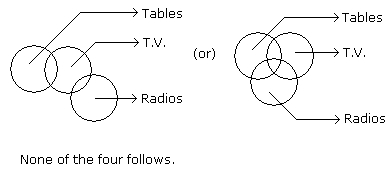Verbal Reasoning - Syllogism - Discussion
Discussion Forum : Syllogism - Syllogism 2 (Q.No. 5)
Directions to Solve
In each of the following questions two statements are given. Which are followed by four conclusions (1), (2), (3) and (4). Choose the conclusions which logically follow from the given statements.
5.
Statements: Some tables are T.V. Some T.V. are radios.
Conclusions:
- Some tables are radios.
- Some radios are tables.
- All the radios are T.V.
- All the T.V. are tables.
Answer: Option
Explanation:

Discussion:
33 comments Page 2 of 4.
Anubhav said:
8 years ago
We have to choose the diagram with minimum intersection. That is the first one.
Sruthi said:
8 years ago
@Ranveer.
From what you have said I understood how the first two conclusions were wrong but I don't understand about 3 and 4 can you please explain.
From what you have said I understood how the first two conclusions were wrong but I don't understand about 3 and 4 can you please explain.
Bubu said:
8 years ago
No, according to me, the answer is 1, 2.
Abhi said:
8 years ago
According to me, the answer is 1, 3, 4.
Ranveer said:
9 years ago
Hi Friends,
When there is no direct relationship given between two statements then the following conclusion is always wrong. In this question, there is no direct relationship given between radio and table and hence conclusions 1 and 2 are false, 3 and 4th are very straight forward. However, you may think that there is a possibility that few radios are the table and vice versa but in that case word possible should be in conclusion (like is it possible that few tables can be radios) normally it doesn't have so I don't think you should take it as the true statement.
Thanks.
When there is no direct relationship given between two statements then the following conclusion is always wrong. In this question, there is no direct relationship given between radio and table and hence conclusions 1 and 2 are false, 3 and 4th are very straight forward. However, you may think that there is a possibility that few radios are the table and vice versa but in that case word possible should be in conclusion (like is it possible that few tables can be radios) normally it doesn't have so I don't think you should take it as the true statement.
Thanks.
Siri said:
9 years ago
I didn't understand this problem. Please tell me the answer with the clear explanation.
Siri said:
9 years ago
I didn't understand this problem. Please tell me the answer with the clear explanation.
Sabir said:
1 decade ago
Please explain which figure we have to use to deduce result. Tell me the importance of these two figures. ?
According to figure 1- answer is (E) and according to figure 2 answer is different.
According to figure 1- answer is (E) and according to figure 2 answer is different.
Faithful said:
9 years ago
@Sanjay.
In that case, the option of only 1 and 2 will be the correct answer. The best way to approach this is to apply the Venn Diagram Method.
I totally agree with your answer @Bala.
In that case, the option of only 1 and 2 will be the correct answer. The best way to approach this is to apply the Venn Diagram Method.
I totally agree with your answer @Bala.
Sanjay said:
9 years ago
For the same question stated above what if they had given an option as ("only 1 and 2") and also the option ("None of These ") what would have been the answer then?
Post your comments here:
Quick links
Quantitative Aptitude
Verbal (English)
Reasoning
Programming
Interview
Placement Papers